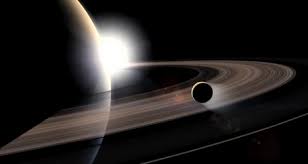Cassini probe sees plastic ingredient on Titan moon Titan - has detected propene or propylene -

The Cassini probe has detected propene, or propylene, on Saturn's moon Titan.
On Earth, this molecule, which comprises three carbon atoms and six hydrogen atoms, is a constituent of many plastics.
It is the first definitive detection of the plastic ingredient on any moon or planet, other than our home world, says the US space agency (Nasa).
The discovery, made by Cassini's infrared spectrometer, is reported in Astrophysical Journal Letters.
"This chemical is all around us in everyday life, strung together in long chains to form a plastic called polypropylene," said Conor Nixon, a Nasa planetary scientist from the agency's Goddard Space Flight Center. A classic example would be the plastic boxes used to store food in kitchens worldwide.
Titan is dominated by hydrocarbons - principally methane, which after nitrogen is the most common component of the atmosphere.
Sunlight drives reactions that break apart the methane, allowing the fragments to join up and form even bigger molecules.
Other common species seen at the moon as a result are propane, which on Earth is used in portable cooking equipment, and ethane, which is the raw material for another ubiquitous plastic - polyethylene.
But the likes of methane, propene, propane and ethane are dwarfed by some truly colossal hydrocarbons that have been detected in Titan's atmosphere.
When the effects of ultraviolet light are combined with the bombardment from particles driven in Saturn's magnetic field, it becomes possible to cook up some very exotic chemistry.
Cassini's plasma spectrometer has seen evidence for hydrocarbons with an atomic mass thousands of times heavier than a single hydrogen atom.
Read more -
The Cassini probe has detected propene, or propylene, on Saturn's moon Titan.
On Earth, this molecule, which comprises three carbon atoms and six hydrogen atoms, is a constituent of many plastics.
It is the first definitive detection of the plastic ingredient on any moon or planet, other than our home world, says the US space agency (Nasa).
The discovery, made by Cassini's infrared spectrometer, is reported in Astrophysical Journal Letters.
"This chemical is all around us in everyday life, strung together in long chains to form a plastic called polypropylene," said Conor Nixon, a Nasa planetary scientist from the agency's Goddard Space Flight Center. A classic example would be the plastic boxes used to store food in kitchens worldwide.
Titan is dominated by hydrocarbons - principally methane, which after nitrogen is the most common component of the atmosphere.
Sunlight drives reactions that break apart the methane, allowing the fragments to join up and form even bigger molecules.
Other common species seen at the moon as a result are propane, which on Earth is used in portable cooking equipment, and ethane, which is the raw material for another ubiquitous plastic - polyethylene.
But the likes of methane, propene, propane and ethane are dwarfed by some truly colossal hydrocarbons that have been detected in Titan's atmosphere.
When the effects of ultraviolet light are combined with the bombardment from particles driven in Saturn's magnetic field, it becomes possible to cook up some very exotic chemistry.
Cassini's plasma spectrometer has seen evidence for hydrocarbons with an atomic mass thousands of times heavier than a single hydrogen atom.
Read more -

No comments:
Post a Comment